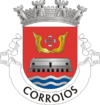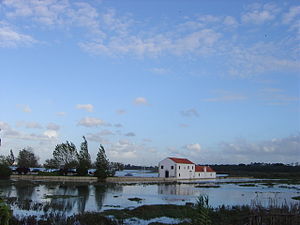- Corroios
-
Corroios — Parish — 
Coat of armsCountry Portugal Municipality Seixal Area - Total 16.92 km2 (6.5 sq mi) Population (2001) - Total 46,475 - Density 2,746.7/km2 (7,114/sq mi) Postal code P-2855 Corroios Coordinates 38°39′N 9°09′W / 38.65°N 9.15°WCoordinates: 38°39′N 9°09′W / 38.65°N 9.15°W Website www.jf-corroios.pt Corroios is a Portuguese town and parish, located in the municipality of Seixal. It has a 2001 population of 46,475 inhabitants and a total area of 16.92 km² and the density is 2,746.9/km². Corroios remains as the second most populous town in Portugal, after Algueirão-Mem Martins (note: this ranking includes only vilas [towns] and excludes cidades [cities]). The town is located on the south side of the Tagus River. This river has on the other side Lisbon, the capital of Portugal. Corroios has several neighborhoods like Vale de Milhaços, Alto do Moinho, Santa Marta do Pinhal, Miratejo, Pinhal de Vidal and Verdizela. Corroios has a lot of immigrants, mainly from Africa but also from Eastern Europe and Asia and one third of the population is below the age of 25 years old.
Contents
History
The oldest traces of human presence in the Corroios territory date from the Roman occupation and can be found in Quinta do Rouxinol.
In 1385 Almada, including a part of Corroios, was donated to John Constable Nuno Alvares Pereira by King João I. D. Nuno used his land in Corroios to create a farm and in 1403, he built the first mill of the municipality of Seixal.
The Corroios parish was founded in 1369, in those days a part of the larger Almada that encompassed most of the current territories of Almada and Seixal.
During the Age of Discovery, this was an important loading area of shipments to Lisbon.
With the creation of the Municipality of Seixal on November 6th, 1836, Corroios was extinct and merged into the Freguesia of Amora. Finally, on April 7th, 1979, after a long period of almost 150 years, the Freguesia of Corroios was restored to an independent village.
On May 20th, 1993, Corroios rose into a town.
Furthermore Corroios has an important natural heritage, which deserves mention in the Sapal Corroios and is integrated in the REN-National Ecological Reserve.
Localities
The parish has the following neighborhoods:
Sites of interests
- Roman site of Rouxinol
- Moinho de Maré de Corroios or Moinho do Castelo
- Fábrica de Pólvora de Vale de Milhaços or Fábrica da Pólvora Negra
Education
Corroios has six primary schools, two secondary schools and one high school:
- Escola Secundária João de Barros
- Escola Básica 2º e 3º Ciclos de Corroios
- Escola Básica 2º e 3º Ciclos de Vale de Milhaços
- Escola Básica 1º Ciclo Nº1 de Corroios
- Escola Básica 1º Ciclo Quinta do Campo
- Escola Básica 1º Ciclo Alto do Moinho
- Escola Básica 1º Ciclo Dom Nuno Álvares Pereira
- Escola Básica 1º Ciclo Quinta da Cabouca
- Escola Básica 1º Ciclo Miratejo
Culture
- Festival de Música Moderna de Corroios (Corroios Modern Music Festival) - March
- Concurso de Fotografia de Corroios (Corroios Photography Concourse) - June
- Animação de Espaços Públicos (Public Space Animation) - July
- Festas Populares de Corroios (The People's Festival of Corroios) - August
- Festival de Vídeo de Corroios (Corroios Video Festival) - VIDEOCOR - November
External links
- Official website (Portuguese)
Aldeia de Paio Pires | Amora (Cruz de Pau) | Fogueteiro | Foros de Amora) | Arrentela | Corroios (Alto do Moinho | Miratejo | Santa Marta do Pinhal | Vale de Milhaços) | Fernão Ferro | Seixal
 Categories:
Categories:- Parishes of Portugal
- Seixal
Wikimedia Foundation. 2010.

